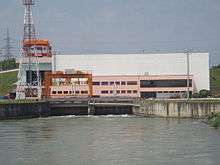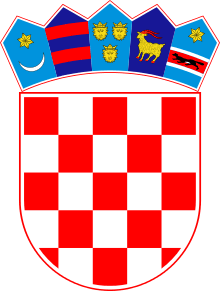Energy in Croatia
Energy in Croatia describes energy and electricity production, consumption and import in Croatia.
Croatia satisfies its electricity needs largely from hydro and thermal power plants, and partly from the Krško nuclear power plant, which is co-owned by Croatian and Slovenian state-owned power companies.
Hrvatska elektroprivreda (HEP) is the national energy company charged with production, transmission and distribution of electricity.
In 2009, electricity consumption totaled 17.5 terawatt-hours, which is about 1% less than in 2008.[1]
Electricity
Production

Total installed capacity of generating objects built in Croatia amounts to 3745 MW, 2079 MW of which is hydropower's share, and 1666 MW comes from thermal power plants. There are 25 hydroelectric power plants, most of which are located on the coast (including the single pumped storage hydroelectric plant, RHE Velebit), and 7 thermal power stations, 3 of which also generate heat for industry and heating in cities. Also, 338 MW is available from the co-owned Krško Nuclear Power Plant, and 210 MW from the privately owned Plomin 2 thermal power plant.[2]
In 2009, domestic production amounted to 12015 GWh, which was 67.9% of total domestic demand. Remaining 32.1% was covered through trade. Total consumption equaled 17697 GWh, a 1% decrease from 2008.[3]
Transmission
Croatian transmission grid consists of lines on three different rated voltage levels, namely 400, 220 and 110 kV. Total length of high-voltage lines is 7,315 km (4,545.33 mi).
The grid was often the target of attacks during Croatian War of Independence, resulting in frequent black-outs during the period. Since then, the grid has been repaired, and reconnected to synchronous grid of Continental Europe synchronous zones 1 and 2, making it an important transit system again.[4]
Distribution
Under the 2004 Energy law, customers in Croatia are allowed to choose their preferred distributor of electricity. However, HEP Operator distribucijskog sustava or HEP-ODS (a Hrvatska elektroprivreda subsidiary) remains the largest distributor to both industry and households. Its distribution grid is 132,938 km (82,603.84 mi) long, with 26 764 transformers installed, totaling 14 170 MVA of power.
In 2009 there were 2 310 811 customers, 90.8% of which were households.[5]
Nuclear power
Croatia has no nuclear power plants on its territory. Croatia co-owns the Krško Nuclear Power Plant together with Slovenia; the Krško plant was built in the era of Yugoslavia on the territory of present-day Slovenia. As of 2008, 17% of Croatia's electric energy consumption is supplied by Krško plant,[6] which is expected to be decommissioned in 2023.[7]
In 1978, the Adriatic island of Vir was selected as a location for a future nuclear power plant, but these plans were abandoned.[8]
According to reports, since 2009 Croatia has been discussing the option of building a nuclear power plant with Albania, in a location on the shore of Shkodër Lake, on the border with Albania and Montenegro. In April 2009 Croatian government denied that any agreement had been signed.[9]
In a 2012 poll among 447 Croatian citizens, who were asked "Do you think it is justified to use nuclear energy for the production of electricity?", 42% answered "yes" and 44% answered "no".[10]
See also
References
- "HEP 2009 annual report" (PDF). Archived from the original (PDF) on 2011-09-30. Retrieved 2011-08-14.
- http://www.hep.hr/proizvodnja/en/basicdata/default.aspx HEP Basic Production Data
- http://www.hep.hr/ops/en/hees/data.aspx HEP electricity data
- http://www.hep.hr/ops/en/hees/default.aspx HEP Croatian power system
- "HEP ODS 2009 annual report" (PDF). Archived from the original (PDF) on 2011-09-11. Retrieved 2011-08-14.
- "2014. Hrvatska bez nuklearke u mraku". Nacional (in Croatian). No. 642. 3 March 2008. Retrieved 30 October 2016.
- "Nuklearna elektrana". Croatian Encyclopedia (in Croatian). Retrieved 30 October 2016.
- "Rajski otok za divlju gradnju". Nacional (in Croatian). No. 441. 27 April 2004. Retrieved 30 October 2016.
- "Croatia Denies Nuclear Plant Contract". climatesceptics.org. 21 April 2009. Retrieved 9 April 2013.
- "Stav javnosti o potrebi izgradnje odlagališta radioaktivnog otpada u Republici Hrvatskoj" [Public opinion on necessity for construction of repository in the Republic of Croatia] (PDF). Rudarsko-geološko-naftni Zbornik (in Croatian). Faculty of Mining, Geology and Petroleum Engineering, University of Zagreb. 24 (1): 73–80. July 2012. Retrieved 30 October 2016.

